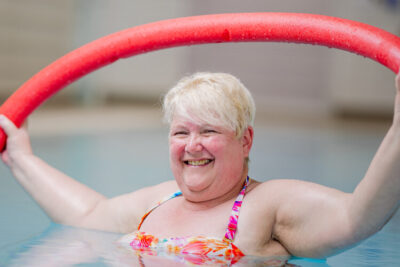
The Warrior Project: Portrait of Beth
by Karen Shaw
Lancashire photographer Donna Craddock loves to capture the perfection in everyone from behind her lens. Her Warrior Project is a series of stunning shoots featuring people with a physical or mental illness or disability. In this issue, we meet our next incredible warrior Beth Parker…
The 29-year-old has battled for years to have her medical issues acknowledged and treated by doctors. A model working under the name Veedma, Beth was discovered by Donna through her modelling work but now can only do the occasional shoot due to her medical issues.
“I haven’t been able to work for a while now. On the good days I love hiking, caving, climbing anything outdoorsy really,” Beth explains. “On the bad days, I’m happy cuddling my six animals, doing a bit of drawing and watching a good serial killer documentary.”
Beth’s love for horror is captured in the dark, sultry atmosphere of Donna’s shoot, capturing Beth’s personality and the juxtaposition that occurs daily while living with an invisible illness. While Beth appears healthy and strong, at the time of the shoot she was living with multiple illnesses and was recovering from surgery after having a brain stem tumour removed, and admits the shoot was a struggle due to tiredness, and Donna had to work fast to capture the images.
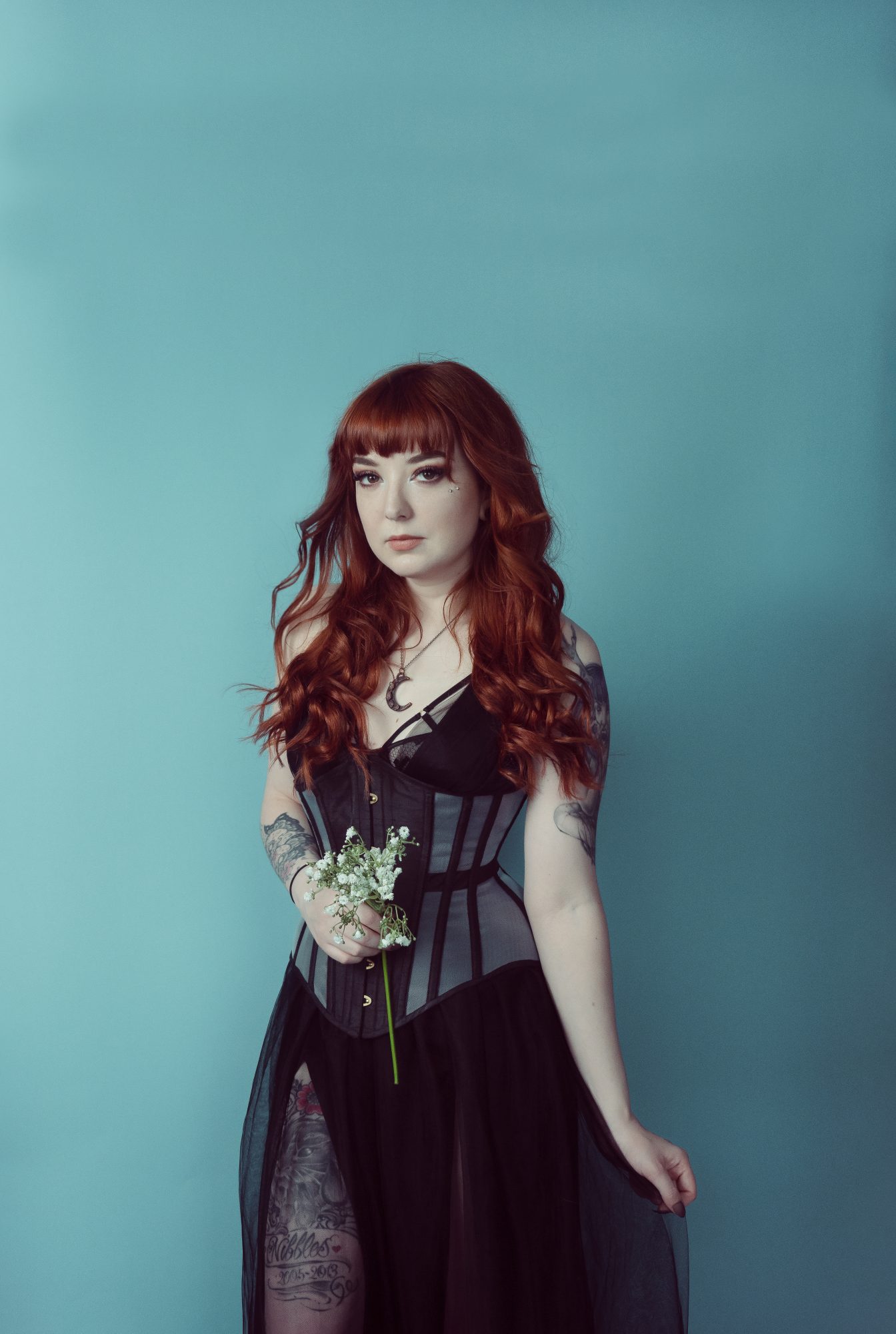
Beth
“My journey began while I was training for the army in 2010,” Beth explains. “That’s when my health started to decline and I was diagnosed with an over-active thyroid and not long after, a thyroid storm.”
“…with but invisible illnesses mean most people think you are just being over dramatic and lazy!”
A Thyroid storm, also referred to as a thyrotoxic crisis, is an acute, life-threatening, hypermetabolic state induced by the excessive release of thyroid hormones.
“This resulted in me failing my army medical which was devastating to me as it was something I wanted to do from a small child. Over the years I tried to hold jobs down and was always getting in trouble for being physically sick, having panic attacks, being exhausted and falling asleep at work.
“Over time things started to make sense as to why I was feeling so awful as my thyroid was out of control and I was given radioactive iodine to help, but this just made me worse making my thyroid go underactive, scarring my throat and activating Graves eye disease.
From 2010 to 2017, Beth was diagnosed with six further illnesses: fibromyalgia, a long-term condition that causes widespread pain; adrenal fatigue; chronic fatigue; chronic migraines, an overactive bladder; and Ehlers-danlos syndrome hypermobility which affects the connective tissue and can cause a variety of symptoms including joint pain.
“All of these conditions are extremely exhausting, debilitating and bloody hard to cope with but invisible illnesses mean most people think you are just being over dramatic and lazy!”
Suffering from crippling migraines, it alarmed Beth when the migraines suddenly worsened in 2016. “I didn’t think they could get worse!” She admits. “I had so much pressure in the base of my skull and it put me in bed throwing up for days.”
“This was one of the most risky and serious surgeries to perform and there was a 20% chance I wouldn’t survive.”
Beth raised her concerns to her doctor, then her neurologist who put down her symptoms to severe migraines. In debilitating pain, Beth did what many of us do when in pain – she googled and discovered her symptoms matched those of a brain stem tumour. “I pushed for an MRI and I was laughed at.”
Eventually, her doctor reluctantly agreed to investigate the pain. “And there it was,” Beth says. “Right, where I said it would be. I was told that it was a hemangioblastoma inside of the brainstem and C1 spinal cord. They said it was impossible to feel and it was put down to an incidental finding.”
Beth was advised that the tumour was benign and slow-growing, it would likely take 20-30 years to increase in size and it would be safer to leave it where it was for now.
“Over the next year I thought I was having seizures,” Beth says. “I was told my symptoms were just in my head and was even sent for a psychological exam which I passed but it was horrific all the same. The people who were meant to care for me didn’t even believe me. I even heard nurses whisper in halls saying ‘leave her to it, she’s not having seizures, she’s just after attention’. After seeing a seizure expert and given the right tests I was officially diagnosed with seizures as there was clear seizure activity in my brain.”
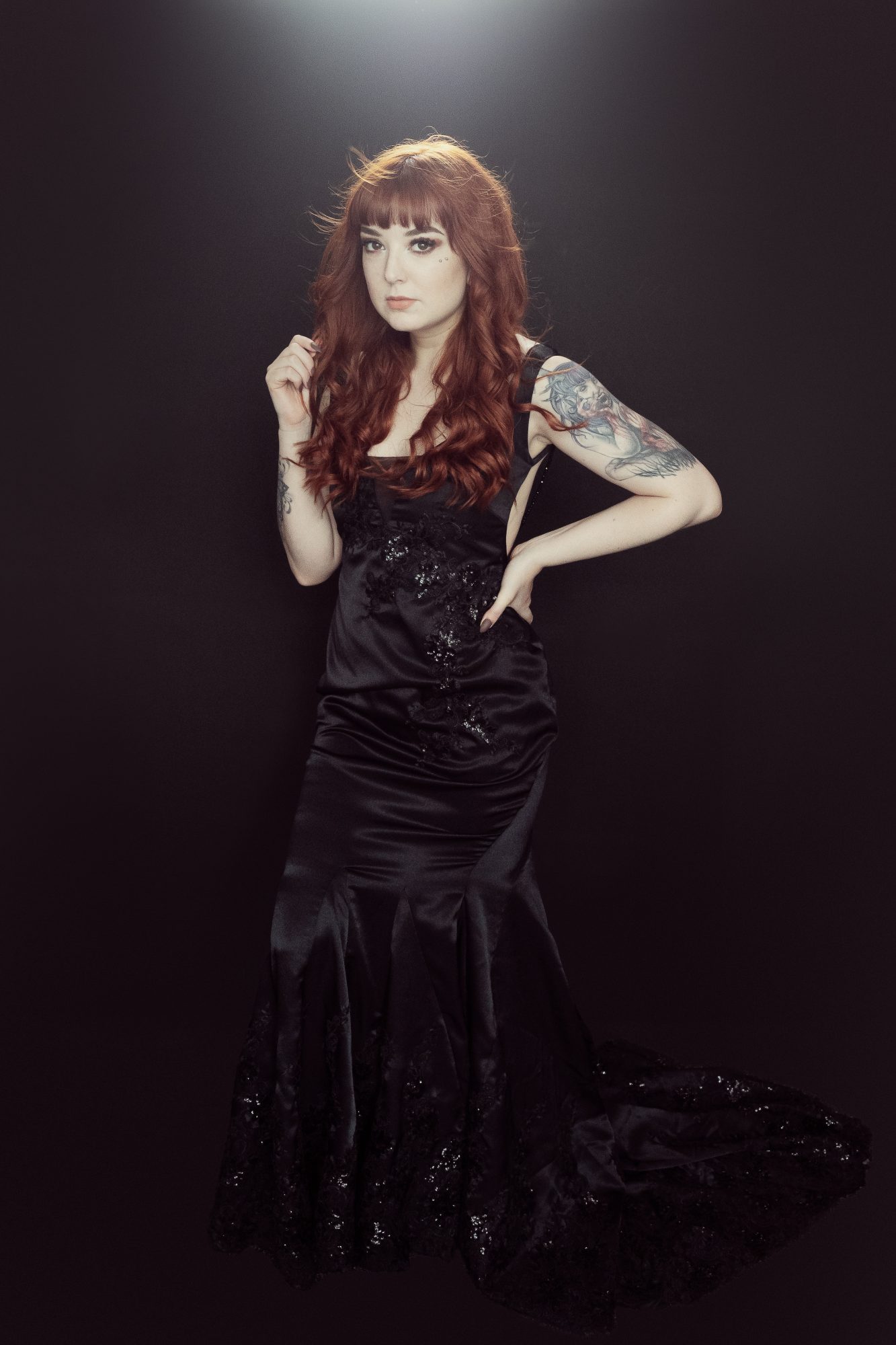
But Beth’s health was still declining. “I was losing feeling in my left side, there was ringing in my ears, vomiting, seizures, balance issues, memory loss, nausea, numbness and constant pain. Me and my mum spent many a time begging for help for me to be told I couldn’t be having these symptoms.”
Doctors put Beth’s symptoms down to the stress of living with a tumour. However, after a routine scan, Beth was called in to see her surgeon. “He was shaking like a leaf. He told me the tumour had grown.”
They would have to operate, but the hospital she was under had a zero-success rate with removing tumours from inside the brainstem. Beth had to seek out a referral to a different hospital herself, and she was placed under the care of Mr D’urso.
“Straight away he was incredibly kind. He was shocked that I’d had no help or relief and immediately put me on steroids. He told me the fluid was also growing and that my brainstem was being crushed.
“This was one of the most risky and serious surgeries to perform and there was a 20% chance I wouldn’t survive. My family was told that I might need to learn to walk and talk again but he was confident that he could save me and I would be okay. We all trusted him completely.”
In the days leading up to the surgery, Beth tried to conceal her feelings not to scare or upset her family even more. “Before surgery, I wrote everyone letters and planned my funeral just in case I didn’t make it. I just felt really bad for my family and my boyfriend. I cried, but for them not for me, because if I didn’t wake up I wouldn’t even know about it or have to deal with it.
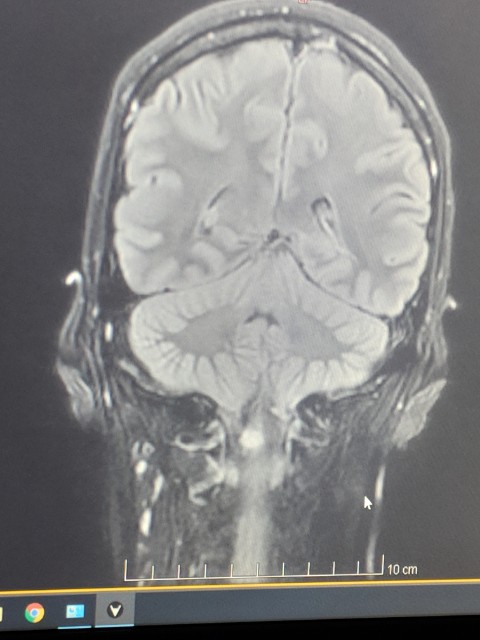
Beth’s scan
“I woke about nine hours later in the recovery room after an eight-hour surgery. I remember a lovely nurse stroking my hair and the first thing I did was think of Beatrix in Kill Bill saying, ‘wiggle your big toe’, and what a relief it was to know I could move my legs! My surgeon came to see me and he had tears in his eyes. He said he couldn’t believe how alert I was – he was so happy to hear me talk.
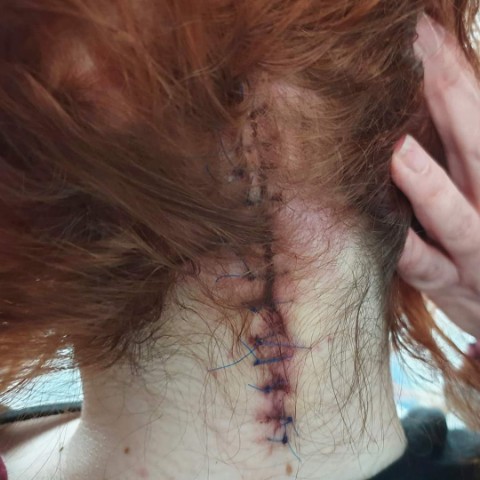
Beth shows her scar
They tested my movement and I couldn’t move or feel much of my right arm or hand but I didn’t care because I was alive. It took about nine months for me to regain more feeling and strength.
The surgery also provided Beth with another diagnosis after the surgeon found a growth inside her pituitary gland, adding endometriosis to the list of conditions Beth is learning to live with.
“My advice to others is always trust your gut – you know your body better than anyone.”
“Day to day is different. Some days I feel great. But other days I’m in so much pain again that I’m in bed all day, but if I’m not doing great I just accept it. If I need to sleep, I sleep. I think it’s very important to listen to your body. It’s good to push yourself but just know your limit. If I’m doing something that I know will take a lot of energy then I will rest for a few days beforehand because I know it’s going to take it out of me and then I’ll be buggered for days after it too. But that’s okay.”
Since the surgery, Beth discovered a cyst in her right cheek which needed surgically removing and is still fighting for a diagnosis for pain and weakness on the right-hand side of her body.
“My advice to others is always trust your gut – you know your body better than anyone.”
Having overcome brain stem tumour surgery, Beth’s photo shoot with Donna is a celebration of her life and the start of the next phase of her journey as she trains to become a paramedic.

“I loved my photo shoot with Donna. My photo shoots have always made me feel empowered and strong. Before I got sick they used to mainly be a confidence boost as I was bullied so badly. But now I look at the images and think how bloody amazing it is that I have survived a brainstem tumour and I’m still here doing photo shoots!”
Go to www.clickclickbang.co.uk for more information about the Warrior Project.
Northern Life May/June 23



